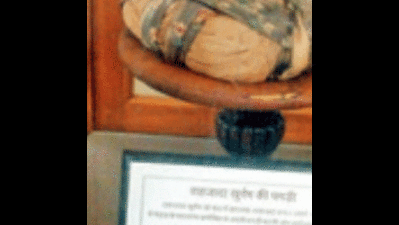- News
- City News
- jaipur News
- Shah Jahan’s turban, tales enthral visitors at museum
Trending
This story is from April 18, 2016
Shah Jahan’s turban, tales enthral visitors at museum
Udaipur's public museum, the very first in state, is a treasure of heritage items. A rich collection of 8,000 miniature paintings is available here which is considered to be the largest collection of Mewar art in the world.

Udaipur's public museum, the very first in state, is a treasure of heritage items. A rich collection of 8,000 miniature paintings is available here which is considered to be the largest collection of Mewar art in the world.
Udaipur: Udaipur's public museum, the very first in state, is a treasure of heritage items.
A rich collection of 8,000 miniature paintings is available here which is considered to be the largest collection of Mewar art in the world. Students from India and abroad come to this museum to study the miniatures. The cultural gallery here exhibits Mewari printed clothes, ivory art specimens, turbans, weapons which are a centre of attraction.
The most attractive objects of all is the turban (pagri or head gear) of Shahzada Khurram, the Mughal prince, who later came to be known as Emperor Shah Jahan. In 1622 AD, Khurram revolted against his father Jahangir and while going to the south he stayed in Udaipur for some time along with his family. He developed a bond with Maharana Karan Singh of Mewar and established brotherly relations with him by presenting him with a ‘pagri'. In the ancient times, a pagri was considered a man's prized belonging and a symbol of dignity.
Even today, the pagri Khurram put on Rana Karan Singh's head to establish brotherly relationship is present in the museum as a living proof of the custom which they started by exchanging turbans. The legend says that Maharana Karan Singh helped Khurram as he was born to a Rajput mother. The former provided Khurram a safe haven in the City Palace of Udaipur. The Mughal aristocrats were unable to adhere to the Rajput customs, subsequently Karan Singh shifted them to the Jag Mandir, a magnificent palace on the Pichhola Lake, to serve as a hiding place for Khurram and his family. During his stay at Jag Mandir in 1623-24, Mughal Emperor Shah Jahan imbibed several ideas, especially of pieta dura work. It later inspired the making of Taj Mahal!
The Government Museum of Udaipur is one of the oldest of its kind in the state. In the period of Maharana Sajjan Singh (1874-1884), the antiquities were collected. On the occasion of Queen Victoria's golden jubilee celebration in 1887, Maharana Fateh Singh constructed a new building in Sajjan Niwas Garden and then named it as Victoria Hall Museum. In 1968, the museum was shifted from the garden to City Palace campus.
The museum has five galleries customised for relevant objects. "In the inscription gallery, ebigraphic material of 2nd century to 19th century obtained from Mewar area is housed. Among these, the oldest one is Ghosundi inscription discovered from a village of the same name in Chittorgarh," informed Mubarik Hussain, the museum superintendent.
"Apart form this, the Nandsha inscription of 282 Vikram Samwar from Bhilwara, Kalyanpur and Kumbhalgarh inscriptions are main attractions for researchers. One inscription in Persian language also gives important information related to ruling period of Gayasuddin Tugluk. Our painting collection is amazing," Hussain adds. In the collection, the miniatures are bracketed from mid-17th century to 19th century. Miniatures based on subjects like Geet Govind, Rasik Priya, Prithviraj Raso, Kadambari, Mahabharat are also displayed here.
during his stay in 1623-24. The Palace was completed by Maharana Jagat Singh during his reign (1628-1652) after the death of Karan Singh. The present form of the Palace is the result of further additions that were made to it by Maharana Jagat Singh. Talking about the historical facts, Maharana Swaroop Singh sheltered a number of European families in this Palace, during the revolt of 1857.
Box
Islamic architecture in Rajput palace
In Jag Mandir Palace, Gul Mahal catches attention as this is the place where Prince Khurram lived with his family. Gul Mahal is made in the Islamic style of architecture, which states that Karan Singh kept in mind the taste of Khurram. The hall has amazing interiors and is decorated with the Muslim crescent. To serve the religious purpose of Khurram, a mosque was also constructed in the complex of the Palace. Another attraction of this Palace is the courtyard, which is festooned with black and white tiles.
End of Article
FOLLOW US ON SOCIAL MEDIA










